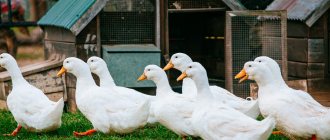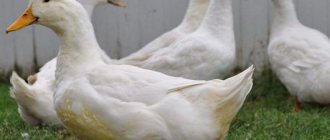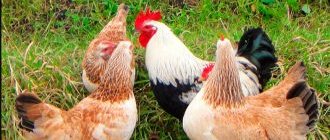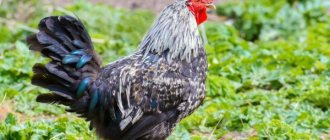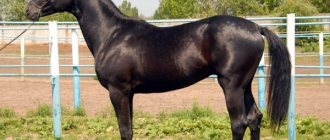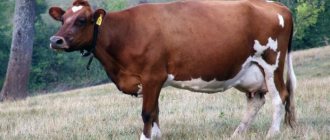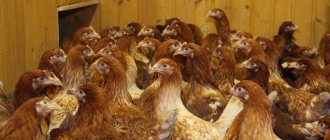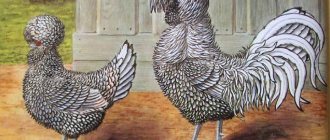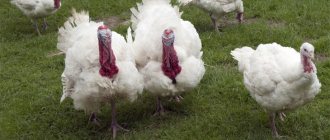History of the formation of the breed
The Agidel duck was bred in Russia as a result of the selection of 3 breeds - Blagovarskaya, Super M and Indian runners. The first broiler-type hybrid appeared in 2000 in the Republic of Bashkortostan.
Blagovarian duck
Duck of the “Super M” breed
Indian Runner Ducks
Duck "Agidel"
Two Agidel breeds appeared at once - A34, A345, which differed in productivity indicators. The main goal of breeders is high meat productivity with low fat content. Experiments by domestic breeders continued in the 21st century.
Characteristics of the Agidel duck
These snow-white birds walk majestically around the garden plot, attracting attention with their impressive appearance and balanced character. This egg-meat breed is often used for mass breeding, since it is unpretentious in nutrition and produces healthy meat and eggs.
Agidel ducks provide high meat quality, and snow-white feathers are used in light industry for insulation. Birds do not cause problems on the farm; they have a well-developed instinct of self-preservation and an easy-going nature.
How to provide chicks with adequate nutrition
To feed young agidels, ready-made mixtures or crushed grains are used. Their diet is gradually supplemented with:
- greens;
- whole grains;
- corn cake.
In the future, Agidel ducks will give the greatest preference to grains. If there is a need to switch to a different type of food, the diet is changed gradually (it takes about 4-7 days). You should make sure that the new menu is sufficiently balanced and contains all the necessary vitamins and minerals.
Description of the breed
Representatives of this breed have 2 important indicators - white feathers and rapid weight gain. A drake weighs 3.2 kg at 6 weeks, a duck weighs up to 3 kg. The weight of adult broilers varies from 3.5 to 5 kg. In addition to meat, the duck produces up to 250 large eggs, which also become an additional source of income for breeders.
The Agidel duck has 2 crosses - A34, A345. One breed is egg-laying, the second is more meat-bearing. When breeding poultry, this is the determining selection criterion for most breeders. Agidel meat duck is more in demand.
Duck body structure
The bird has a large head, a wide pink beak and high-set dark eyes. The neck is massive and elongated, descending to the chest protruding forward. The back is wide and long, the body has a horizontal direction.
The paws are shortened and massive, have a light orange color. The bird stands confidently on its feet and moves around the yard with a leisurely, club-footed gait.
Plumage
A distinctive feature of Agidel ducks is their snow-white feathers. There should be no yellow, beige or cream shades in the color, otherwise doubts arise about the purebred of the breed. This fact is fixed in the genotype of the cross. When spots or a set of colors appear, we are talking about mestizos, representatives of other breeds.
The wings are medium in size, white feathers are tightly pressed to the body, which allows them to quickly adapt to low temperatures and tolerate cold weather more easily. The thermal properties of feathers are actively used for the production of insulation when sewing clothes and bedding.
Duck character
Agidel ducks are calm and balanced. They move slowly around the yard, rarely quack, look for food without fuss and quickly gain weight. Poultry can be kept in pens and free-grazing without fear for the quality of the carcasses.
If a duck experiences a feeling of anxiety, it begins to quack loudly and for a long time. Calming a bird is not so easy. The breeder must pay attention to this signal and promptly provide assistance to the frightened duck.
Agidel ducks behave calmer if there is a body of water nearby. Without it, the bird also feels comfortable, but every day it needs unhindered access to water to wet its feathers.
Productivity
Duck is a meat breed. Its carcass has an aesthetic appearance (without black stumps) and weighs up to 3 kg. At the age of 2 months the duck is slaughtered. The result is dietary meat, rich in protein, vitamins, and beneficial microelements.
The female brings offspring 2 times a year. Possessing high fertility, the bird lays up to 250 large, oval eggs per season. The weight of each varies from 80 to 100 g. Eggs should not be eaten raw. It is better to use them in cooking for making confectionery and baking.
What should a poultry house be like?
As already mentioned, the Agidel duck does not have any special requirements for the arrangement of the shed. However, some rules must still be followed when constructing a poultry house. Despite excellent resistance to various diseases and the ability to quickly adapt to any living conditions, birds of this breed really do not like drafts. Therefore, when building a duck shelter, care should be taken to ensure that there are no cracks in the walls. If the poultry house is a panel house, three boards are placed on the frame: two end-to-end and one overlapping.
It is best to plaster the walls inside the duck house, and fill the remaining cracks near the door and window with polyurethane foam. A bedding of sawdust or straw is laid on the floor. In the future, it will have to be changed from time to time. Otherwise, the bird's feathers will contain parasites. The “population” density in the poultry house should be no more than 2-3 birds per 1 m2.
Content Features
Agidel ducks live in poultry houses. In winter they spend most of their time indoors, in summer they spend the night, hiding from the intense heat. Mandatory conditions are a temperature of up to 5 degrees in the cold season and the absence of drafts, especially during the period of egg laying.
In addition to the house, ducks need access to water. Not far from the premises, install an artificial pond or fence off a natural one, for example, a pond or stakes. For water procedures, bury in the ground and fill an unnecessary container or an old bathtub with water. Alternatively, install a small swimming pool.
Clean the pond and poultry house regularly, otherwise their inhabitants will get sick and infect the entire school. Show your bird to the veterinarian regularly and respond promptly to symptoms of duck illness.
What should a poultry house be like?
This is a bright room, where there are 3 adult individuals per 1 square meter. In a more crowded poultry house, ducks can injure each other, and there is a high probability of developing infections and disease of the entire school. The optimal nest size for 3 individuals is 40x40x35 cm.
Install high-quality ventilation and a heating element in the poultry house. Air purification helps get rid of harmful bacteria, minimizes the risk of disease, and gets rid of gases and persistent bird odors. The heating element is a stove or heating element of your choice, so that the room temperature in winter does not fall below 5 degrees.
Pay special attention to lighting. The poultry house should have windows on the south side. Additionally, install artificial light bulbs to extend daylight hours. Egg production rates depend on this. Closer to winter, daylight lasts 8-9 hours, gradually increasing to 14 hours.
The poultry house needs a warm floor. Cover cold boards with peat or sawdust bedding, otherwise the duck's immunity weakens, and the birds get sick and die more often. Change the litter 2 times a year - in spring and autumn. Make sure it is not wet or dirty.
Before laying, treat the floor with slaked lime and putty the walls. Such measures are necessary to protect against infection.
Care
Ducks are cowardly and wary, and distrust people. You must not frighten the birds, otherwise it will negatively affect their calmness and productivity. Compliance with the rules of care and maintenance of ducks ensures high rates of weight gain and egg production.
The duck tolerates temperature changes well, but in the poultry house the optimal temperature should be no lower than 5 degrees in winter and 17-19 degrees in summer. Ventilate the room daily at any time of the year.
Because ducks have low feet, they often stain the white feathers on their chests. To avoid bringing pollution into the barn, install an artificial pond in the enclosure where the birds can splash and clean themselves.
Nutrition
The Agidel duck is a waterfowl, but there is no need for a natural body of water. A small pool in the enclosure is enough for the bird to wet its feathers.
The basis of the diet for feeding ducks is whole grain feed, which promotes rapid weight gain. High-calorie feed is also useful as an additional source of vitamins, minerals, and microelements.
The bird menu changes depending on the season. The summer diet requires aquatic vegetation, for example, sedge and reeds. The duck finds its own food by grazing near a small pond. If the bird lives in an aviary, give it dried grass.
In winter, ducks do not eat wet food; the basis of their diet is grain, mixed feed, and high-quality hay. To prevent vitamin deficiency, mix dried nettle and shell rock into your food, and do not forget about the benefits of mineral supplements. These include chalk, meat flour, sand, gravel, and table salt.
To improve metabolism, improve digestion and increase weight gain, introduce watermelons and watermelon rinds into your ducks' diet. If the peel is hard, first grind it into crumbs.
Install drinking bowls near the feeders. Ducks drink after every meal. The water should be clean, update the drinking bowl regularly. If algae or mold appears on its walls, wash and disinfect. Otherwise, the bird may get sick.
The duck menu includes boiled vegetables - nourishing and safe for digestion, necessary for weight gain.
Breeding
Agidel ducks have a weakly expressed maternal instinct. Use an incubator to hatch eggs, otherwise the bird will rise from the eggs and they will freeze. The fertilization rate is 94%, hatching of ducklings is 80%. To avoid reducing these indicators, follow the rules for using the incubator:
- Place fresh eggs into the device without cracks or bends.
- Control the temperature according to the incubation period (37-38 degrees).
- Turn the eggs up to 10 times a day to prevent the embryo from sticking to the shell and dying.
- Maintain humidity in the incubator - 60-70% (for the first week), 45% (for the next three weeks).
- Open the device daily for 10-30 minutes to cool the eggs twice a day.
In matters of breeding, you may find our article “Basics of Duck Egg Incubation for Beginners” useful.
Raising ducklings
After hatching, the ducklings should have 24-hour lighting for the first 24 hours and maintain a constant temperature. Keep the babies in a brooder made of galvanized iron and mesh. If it is not available, use a cardboard box. The litter must be clean and dry.
It is not easy to catch a duckling in a spacious enclosure. Difficulties arise during routine vaccination. Other recommendations for raising ducklings:
- Babies have sharp claws, so they can injure their relatives. To prevent this from happening, control the behavior of the young animals and trim their claws with scissors.
- If the duckling is injured, immediately treat the sore spot with brilliant green, otherwise a dangerous infection will penetrate into the wound, which a weak immune system cannot resist.
- When feeding, do not frighten the chicks by scattering grain, otherwise from fright they will crash into the wall and die. Therefore, fill the feeder with food when you enter the poultry house/aviary.
- Make sure that the chicks always have clean water, otherwise digestion is first disrupted, and then the ducklings die.
To prevent intestinal infections, give babies a decoction of calendula for the first month of life (1 tablespoon of raw material per 1 glass of boiling water). Other rules for feeding young animals:
- The ideal option is a special starting mixture.
- From a week of age, introduce cake, greens, crushed grain.
- For bait, use vitamin premixes against rickets, vitamin deficiency, and pecking.
Starting from one month of age, let the ducklings go out to pasture. If the weather permits, it can be done earlier. Make sure that there are no poisonous plants or foreign objects on the lawn, and that there is some water in a specially prepared container.
Feeding
On farms, in order to obtain better results, young animals begin to be fed with compound feed. At the same time, make sure that the ducklings drink a lot of water.
Otherwise, the livestock may develop pathology in the crop and intestines.
For each age, a specific version of the food is used:
- Week 3 – starting version of PC 30-1. 70 g of mixture is calculated for one duckling.
- 4-7 weeks - PC 31-1, teenage version, if the young animals are of egg production and finishing, if meat is expected to be obtained from the bird. Agidel ducks eat 290 g.
- at 8-9 weeks they give the finishing version of PC 31-2. The daily norm is 340 g.
When raising young animals, breeders often resort to a combined feeding method. The diet includes cereals, succulent feed and fertilizing.
Part of the diet, about 30%, is replaced with age-appropriate dry formulas. The amount of feed is kept the same as when feeding the combined mixture.
Young animals gain a lot of weight at an early age, so special attention should be paid to the formation of the duckling's skeleton. Bones must be strong to support high muscle mass.
Chalk, table salt, and bone meal are added to the food. Ducklings are given fish oil once a week.
Diet of an adult bird
When feeding adult livestock, the seasonal feeding method is used. In summer, the bird's diet consists of green grass.
To prevent intestinal blockage, tympany and other diseases, give roughage in the form of chopped hay in the morning.
In the evening, ducks eat a grain mixture of corn and barley. Chalk, salt, and bone meal are added to the mixture. The total amount of feed is 200 g. The livestock eats green grass in abundance.
In summer, egg production in ducks is high. It is necessary to monitor the condition of the egg shell.
If the characteristics are negative, the shell is deformed or has increased elasticity, then phosphorus and calcium additives are added to the feed.
They resort to feeding laying hens with calcium gluconate. If there are layers on the shell, then the amount of chalk and shells is reduced. The diet is saturated with carotene, vitamins are given with drink or in solid form. Carrots and sunflower oil are added to grain mixtures.
In autumn, the molting period begins. The Agidel duck requires more protein feed and mineral salts. In addition to grass, she is given 170 g of grain mixture, 35 g of bran, 70 g of fodder beet, 1.5 g of bone meal, 8 g of chalk, 2 g of salt, 1 g of gravel.
It is necessary to monitor the condition of the pen. If it grows poorly, then the ducks’ body lacks phosphorus and calcium. Premixes and vitamin complexes will help replenish reserves. In the fall, the stock should eat plenty of green grass.
In winter, grain becomes the main food for poultry. It is given 180 g. 40 g of bran, 2 g of yeast, 3 g of bone meal, 9 g of chalk or shells are added to the grain mixture.
Along with protein feed, ducks eat root vegetables. Potatoes are given 60 g per head, carrots 80 g, beets 60 g. To prevent vitamin deficiency and to avoid pecking, cottage cheese, skim milk, and phosphorus additives are added to the feed.
In the spring, the winter diet is maintained, but the amount of grain, bran, and protein supplements is gradually reduced. Green grass is introduced in small portions, and more fodder beets and carrots are given.
Don’t forget about mineral supplements, because birds begin molting in the spring and become sexually active.
A transitional diet is a good prevention against intestinal pathologies. The body needs to prepare to accept large amounts of juicy grass, which the duck population consumes in the summer.
When to slaughter
The ideal time for slaughter is when the duck is 2 months old. The feather is not fully formed, so plucking the carcass will not be much of a problem. In one productive season per year you can get up to 550 kg of duck meat. The carcass is cleaned and attractive to buyers and is in high demand.
Feather and down
Pure white feathers replace swan down, which is used for sewing clothes and bedding. Feathers and down are not expensive, and the clothes are warm and light. In regions with harsh climates they are actively used.
Advantages and disadvantages of the breed
Ducks are unpretentious in food, but this is not the only advantage of the Agidel breed. There are other positive aspects in favor of poultry:
- dietary meat;
- high value of fluff;
- rapid weight gain;
- high egg production;
- stable immunity;
- high fertility.
The Agidel breed has its disadvantages:
- fatty meat;
- lack of maternal instinct in females;
- the need to purchase an incubator;
- restless disposition of the chicks.
Farmers' reviews about the Agidel duck
★★★★★
Ivan, 45 years old, agriculture, Volgograd. I have more than 10 Agidel ducks on my farm.
The birds are unpretentious and prolific, but it doesn’t go beyond eggs. The duck doesn’t want to hatch her offspring, no matter what I tried. But buying an incubator is expensive and expensive. But I’m also pleased with the number of eggs. There is enough for home purposes, and for sales too. So the income is not bad. It's more difficult with carcasses. The meat is specific, and there is not much variety in our farm. ★★★★★
Alexey, 47 years old, farmer, Ivanovo. Agidel didn’t take root with me.
Very restless ducks. They seem to behave calmly and do not attract attention to themselves. Once they get scared, they hiss and quack for half a day and find it difficult to calm down. The disadvantages of the breed do not end there. The meat is fatty and tight, the eggs do not hatch, and it is generally impossible to catch a duck. I struggled with breeding for several months, then gave up and don’t regret it. ★★★★★
Anna Ivanovna, 52 years old, farmer, Vologda region. Ducks tolerate cold and frost well.
The main thing is to insulate the poultry house for the winter and not create drafts in the room. They lay eggs as in summer, but do not hatch eggs. You have to use an incubator. But meat is not very expensive; eggs are ordered more. The ducks lay eggs well. Large eggs with an orange yolk give a rich color to baked goods and an interesting taste to the dough. I convinced myself. Hide
Add your review
Agidel ducks are popular among Russian breeders and are equally distributed throughout the country. They are famous for their dietary meat and large eggs, high fertility and non-conflict nature.
0
0
Copy link
Raising ducklings
Chicks require special attention, as they are very timid . The young animals practically do not allow people to approach them, which is why, even if there is a spacious enclosure in which they can run, it is quite difficult to catch a duckling. This may cause some difficulties when vaccinating poultry.
The claws on the paws are very sharp from birth; if crushed, they can easily seriously injure each other.
For this reason, in order to avoid unnecessary problems, you should immediately, after the chicks have dried, trim the tips of their claws with sharp scissors. The manipulation should be performed very carefully so as not to touch living tissue.
If they are still damaged, then it is necessary to immediately treat the sore spot with brilliant green to prevent suppuration. If ducklings are kept outdoors, it is not necessary to trim their nails.
At the time of feeding, special care should be taken, since the chicks, from fright, when a hand appears, can rush to the walls of the cage, which can even lead to their death. For this reason, it is best to use a feeder for this purpose, into which the food is loaded from the outside.
Ducklings should be fed in the same way as young ducks of other species. You need to start feeding the bird as soon as it has dried out after hatching. Chicks should always have water. It is necessary to monitor its cleanliness.
To prevent intestinal infections, you can give young animals a decoction of calendula flowers, which is prepared at the rate of 1 tablespoon of raw material per 1 liter of boiling water.
